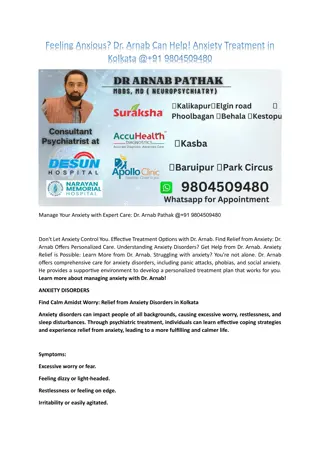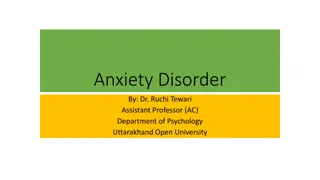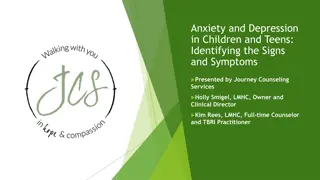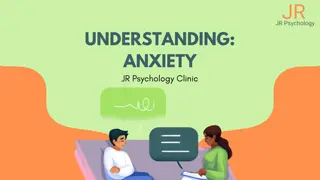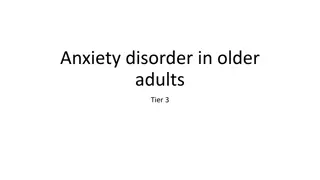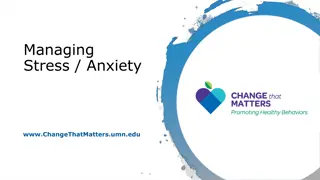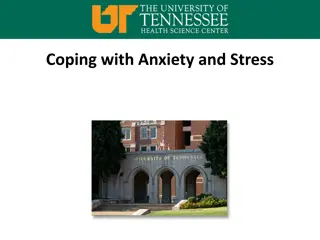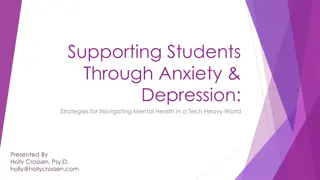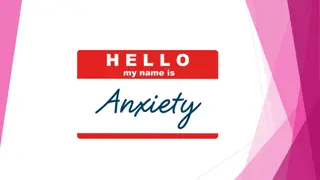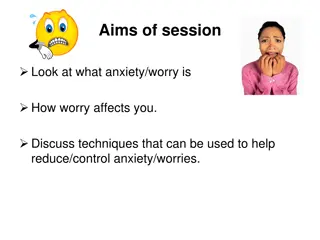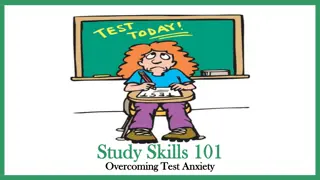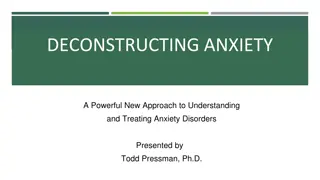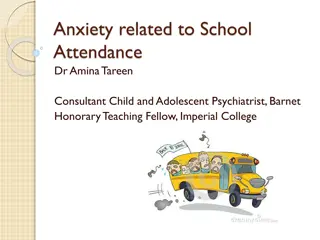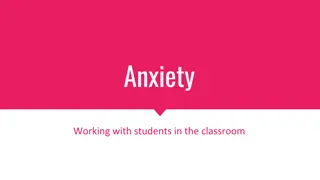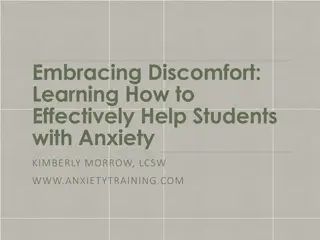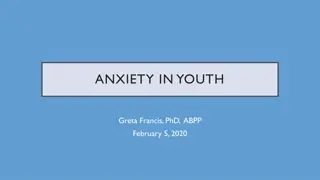Understanding Anxiety: Causes, Symptoms, and When to Seek Help
Anxiety is a natural response to perceived threats, but excessive anxiety can negatively impact daily life. Learn about the causes, symptoms, and effects of anxiety, including how it affects children, and when to seek professional help from a senior clinical psychologist. Recognize typical changes over time in managing anxiety and understand the differences between helpful anxiety responses and overwhelming anxiety. Discover common triggers, symptoms, and ways anxiety impacts various aspects of life, such as family, learning, and self-esteem.
Download Presentation

Please find below an Image/Link to download the presentation.
The content on the website is provided AS IS for your information and personal use only. It may not be sold, licensed, or shared on other websites without obtaining consent from the author. Download presentation by click this link. If you encounter any issues during the download, it is possible that the publisher has removed the file from their server.
E N D
Presentation Transcript
What is anxiety and when to get help Rebecca Somervaille Senior Clinical Psychologist Rivendell SLHD
Helpful anxiety Fear and anxiety is adaptive for managing demanding situations Alerts us to danger ensures safety and survival Body s way of responding to being in danger In the brain... Messages sent from your brain to release adrenaline into your bloodstream throughout your body In the body... Flight or fight or freeze Physiological responses
There is a fire You feel fear and anxiety You flee Your body reacts by making your heart beat fast and your muscles work quickly You think I m in danger
Typical changes over time As children develop understanding of danger they usually develop strategies for managing threat Develop realistic ways of assessing danger Learn coping skills Develop confidence they can manage growing up
What is big anxiety ? Response to threat (real or imagined) Brain is on high alert primitive part of brain amygdala gets activated to protect you even when you don t need protecting! Fight - flight - freeze
How common is anxiety? Anxiety is second most common disorder in children About 7% of child and young people Can have a big impact on daily life
Anxiety affects ... Family life Happiness Learning Exploring Self esteem Friends
Why me? Genetics Biochemical Personality temperament Environment Reaction to anything your child thinks is risky crowds, separations, too much noise, judgments, school, competition
Symptoms Body signals shaking, nausea, jelly legs, heart racing, dry mouth, difficulty concentrating, sweating Thoughts worry, something bad will happen, hard to make decisions, plan, organise What if ? Feelings scared, afraid, irritable, sad, anxious and out of proportion to situation Behaviour escape, avoid, attack, protest, seek reassurance
Vicious cycle Worry Scan for threat Notice physical symptoms Confirms anxiety and threat present Escape / avoidance / safety behaviour Relief Reinforces anxiety beliefs
ANXIETY CURVE Catastrophe Time
Normal worries + extra worries Same worries as all children and young people To excess Unusual worries Children with attention or learning difficulties About keeping up in class About appearing different About the future
Common forms of anxiety Separation distress when away from attachment figures or fromhome Social shy ++, avoid playdates, worry what others think of them Generalised worries about anything and everything and that bad things will happen to themselves and others Obsessive compulsive follow unusual routines or rituals believing they will stop bad things from happening Phobias may prevent them from doing regular activities Panic terrified when no real danger somatic symptoms++
UNHELPFUL ANXIETY You sweat, tremble, feel nauseous You have to do a speech You feel fear and anxiety Your body reacts by going into survival mode (slow digestion, cool body heat, heart rate increases) You think People will laugh at me
UNHELPFUL ANXIETY You are in a crowded place and are short of breath and dizzy You feel fear and anxiety You flee Your body reacts by making your heart beat fast and your muscles work quickly You think I can t breathe and I m going to die
Anxiety or aggression? Imposter!! Not always clingy and fearful behaviour Can be tantrums, meltdowns, aggression Alarm system has been activated
When to be concerned Level of fear out of proportion to Situation Developmental level Or occurs in absence of typical cue Interferes with daily life and gets in the way of normal developmental goals Child or young person starts to avoid situations, seek reassurance and/or use safety behaviours
PREPARING FOR THE WORST AVOIDANCE BEHAVIOURS THAT MAKE US FEEL SAFE ESCAPE OVER THINKING REASSURANCE SEEKING
What kids need to know Normalise as response to threat yet out or proportion to actual threat Maintained by over-estimation of threat PLUS underestimation of coping Avoidance, accommodation and reassurance grow anxiety Have to take anxiety with you!
Talk to your child.. Help them recognise anxiety detect anxious thoughts and avoidance Teach skills think and breathe better Name it to tame it label the big emotion Strong breathing helps reconnect to front of your brain calms the amygdala down Check own responses model brave behaviour avoid reassurance demonstrate confidence in your child s ability
Help available Books and information for resources Apps Online interventions BRAVE program Face to face Talk to your GP School counsellor Psychologist / mental health clinician / psychiatrist Organisations Headspace / NGO s Public services Mental health service Rivendell 9736 2288 Child and family services 9562 5400
Type of help Psychological individual or groups Acceptance and commitment therapies Cognitive behavioural therapy may include Relaxation Controlled breathing Cognitive restructuring Behavioural experiments doing is extremely important!!
Kids helpline 1800 551 800 Raising Children Network Lifeline 131 114 Reachout Headspace Beyond blue



